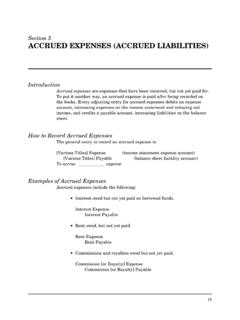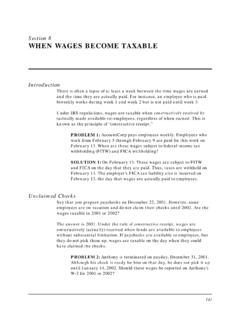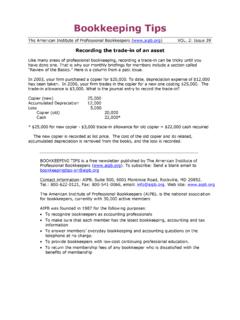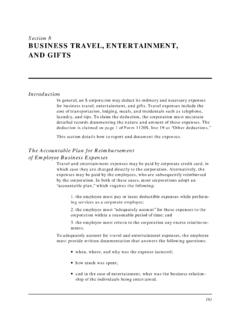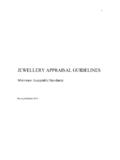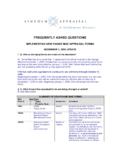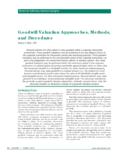Transcription of DEPRECIATION UNDER GAAP (FOR BOOK PURPOSES)
1 Section 2 DEPRECIATION UNDER GAAP(FOR BOOK PURPOSES) IntroductionMost plant and equipment assets wear out or become obsolete over theyears. Similarly, although land is not depreciated (because it does not wearout), improvements to land, such as paving or fences, are depreciatedbecause these improvements wear out or become obsolete over time. Theportion of the asset used up (worn out) each year is referred to asdepreciation. DEPRECIATION for each asset is usually calculated separatelyand is based on four factors:a. the asset s cost; b. the asset s estimated life; c. the asset s residual value (its book value after being fully depreciated); andd.
2 The method of DEPRECIATION the Asset s Cost For DEPRECIATION purposes, the cost (historical cost, original cost oracquisition cost) is more than just the invoice price. It includes any costincurred to acquire, transport and prepare the asset for its intended use, suchas sales tax, commissions, title fees, transportation, and 1: CuCo purchases a machine that has the followingbreakdown of costs: Invoice price, $20,000, sales tax, $1,500, freight,$500, outside contractor to install the machine, $200. For depreciationpurposes, the cost of the machine is $22,200, computed as follows:$20,000invoice price1,500sales tax500freight200set-up (contractor)$22,200total costThus, CuCo records acquisition of the machine as follows:Asset Machine22,200 Cash22,20013 Group PurchasesSometimes a company pays a single price for a group of assets and cannottell from the invoice how much of the freight, installation and other costs areattributable to each asset.
3 Moreover, because one asset may have a life ofthree years, another five years and so on, and because other assets in thegroup may not even be depreciable (such as the land in an acquisition of fiveadjacent buildings), the company allocates a separate cost for each asset. The price of each asset in a group purchase is computed as follows:Specific asset s fair market value (FMV)Total FMV of all assets acquired= rate x total acquisition cost = specific asset s acquisition costPROBLEM 1: MiCo s purchase of a computer, printer and a copierhas an acquisition cost of $6,000. The invoice does not separately listthe cost of each item.
4 What is the acquisition cost of each asset?SOLUTION 1: MiCo estimates, or obtains from a formal appraisal,the FMV of each asset, as follows:AssetFMVC omputer$4,000 Printer1,000 Copier 3,000 Total FMV$8,000 Next, MiCo computes each asset s portion of the total $6,000acquisition cost, as follows:1. To compute the acquisition cost of the computer:$4,000 computer FMV$8,000 total FMV= rate x $6,000 total acquisition cost = $3,000 acquisition cost for the computer2. To compute the acquisition cost of the printer:$1,000 printer FMV$8,000 total FMV= rate x $6,000 total acquisition cost = $750 acquisition cost for the printer3.
5 To compute the acquisition cost of the copier:$3,000 copier FMV$8,000 total FMV= x $6,000 total acquisition cost = $2,250 acquisition cost for the copierMastering Depreciation14To summarize the acquisition cost of each asset, individually:AssetAcquisition costComputer$3,000 Printer750 Copier 2,250 Total cost$6,000 PROBLEM 2: SaCo s purchase of a building and land has a totaloriginal cost (acquisition cost) of $100,000. The purchase contract doesnot separately list the price of the building and the land. The companyestimates the following FMVs for the building and land:AssetFMV Building$ 75,000 Land 50,000 Total FMV$125,000 What is the acquisition cost of the building for DEPRECIATION andrecordkeeping purposes?
6 What is the original cost of the land (forrecordkeeping purposes only, because land cannot be depreciated)?SOLUTION 2: SaCo allocates the original cost of the building andland as follows:1. To compute allocation of the original cost of the building:$75,000 building FMV$125,000 total FMV= x $100,000 total original cost = $60,000 original cost of building2. To compute allocation of the original cost of the land:$50,000 building FMV$125,000 total FMV= x $100,000 total original cost = $40,000 original cost of landContributed AssetsIt is common practice in startup and even in established companies forowners to contribute assets rather than cash in exchange for stock.
7 Thecomputations and journal entries for contributed assets UNDER GAAP or taxrules are done by a CPA and are not included in this course. DEPRECIATION UNDER GAAP (For Book PURPOSES) 15 Determining the Asset s Estimated LifeThe estimated life is the number of years the company expects the asset tolast or the amount of production it expects from the machine measured inhours, miles, units produced, or any other standard. For example, amachine s life may be measured in years, units produced or hours used; anautomobile in years of use or miles driven; and a building in years of the Asset sResidual Value (or ScrapValue or Salvage Value)The residual value is an estimate made by company management of thedollar amount that can be recovered for the asset at the end of its useful lifewhen it is disposed of (sold or traded in).
8 This amount cannot be the residual value is subtracted from the acquisition cost, theremainder is the full amount that can be depreciated and is referred to asthe depreciable cost residual value = depreciable baseTo put it another way, when total DEPRECIATION taken on an asset equals thedepreciable base, the asset has been fully example, if XyCo buys a $20,000 packaging machine and estimates thatat the end of the machine s useful life it will have a residual value of $1,000,the machine s depreciable base is $19,000. XyCo can take a total of $19,000in DEPRECIATION expense over the machine s useful life.
9 If, instead, XyCoestimates that the machine will have no residual value at the end of its life,then the original cost of $20,000 is the depreciable base, and XyCo can take$20,000 in DEPRECIATION expense over the machine s useful a DEPRECIATION MethodUnder GAAP, a plant or equipment asset can be depreciated using one offour basic methods:1. The straight-line (SL) method. The asset is depreciated bydividing the depreciable base (acquisitions cost residual value) bythe number of years in the estimated life to determine each year sdepreciation expense. Thus, UNDER SL, each year s depreciationexpense is the Depreciation162.
10 The units of production (UOP) or units of output asset is depreciated each year according to the number of unitsproduced, total hours used, total miles driven, or other measure ofproduction. Thus, UNDER UOP, the amount of annual depreciationfluctuates by output or The accelerated methods. There are two methods of accelerateddepreciation. They are called accelerated because they provide moreannual DEPRECIATION expense in the earlier years of the asset s life andless DEPRECIATION expense in the later years. The two acceleratedmethods are the declining balance (DB) method and thesum-of-the-years -digits (SYD) method, which are explained in thiscourse in Sections 5 and 6 of the DEPRECIATION method selected or annual DEPRECIATION taken,total DEPRECIATION over the life of the asset is the DEPRECIATION Is RecordedWhen DEPRECIATION expense is recorded at the end of the year, quarter,month or other period, the same accounts are debited or credited in theadjusting journal entry regardless of the method used; only the amount ofdepreciation will be different.

